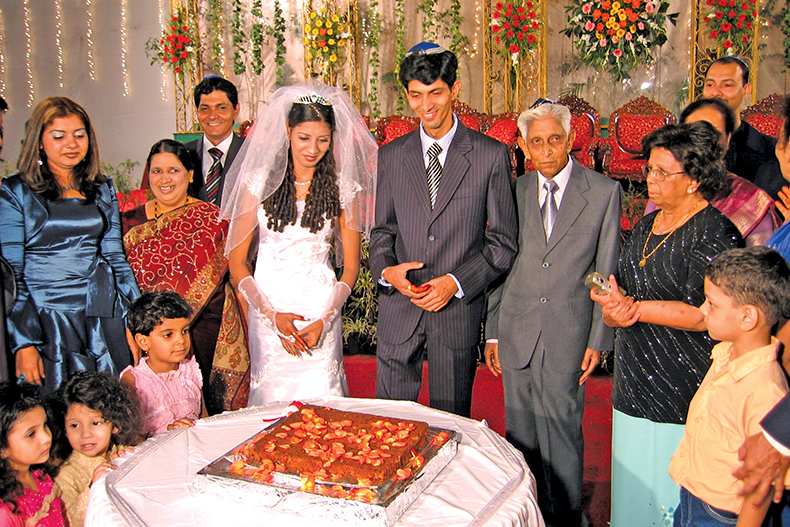I travel the world. When someone mentions Asia, I immediately conjure up mystical India.
Falling in love with “Incredible India,” as the its own ministry of tourism puts it, is not difficult, even though the country often bewilders the visitor who quickly discovers that traversing this ancient land becomes a soul-searching journey.
Hard to believe that India stretches from the tropics right up to the temperate regions, from near the equator to the base of the Himalayas; a vast country, indeed.
“India is history,” wrote the late Jawaharlal Nehru- leader for Indian independence from Britain and the country’s first prime minister- adding that the country “has a long memory.” Indeed; its history reaches back five millennia. And the Jewish people are part of that memory. For more than 2,000 years, pluralist India has been a peaceful home to Jews and has played a significant role in Jewish consciousness.
To reach the India of my people, I flew non-stop, 8,000 miles in 16 hours. As I toured India- the birthplace of three great faiths: Hinduism, Buddhism and Jainism- I could not help but see and sense the tumult, the hustle, the poverty and yes, the inequality that exists in wide segments of the population. Yet, progress moves society forward; now, discrimination on the basis of caste remains illegal.
American visitors usually begin their journey in Delhi, the capital. This is one “corner” of the “golden triangle” of India tourism. Another is Agra, site of the world marvel, the Taj Mahal, and the deserted city of evanescent red sandstone, Fatehpur Sikri, cited as among “the most evocative ruins in India.” The other corner of the “triangle” is Jaipur, home to the Amber Fort, best reached by riding an elephant up a steep road.
Arriving first in Delhi, one of the world’s historic cities, I quickly sought out my people and learned that there are three distinct groups: The Bene Israel trace their roots in India back to the destruction of the First Temple in 586 BCE; today they are the largest group of Indian Jews-most reside in Mumbai. The Cochin Jews, another ancient community, living in Kochi, in southwest India, is another group. Most recent are theBaghdadi Jews who descended from 19th century immigrants from Iraq and other Arab lands.
I stop at the Judah Hyam Synagogue in New Delhi- opposite the Taj Mahal Hotel and near the Christian cemetery- which serves about 100 Jews who live in the capital. Chabad House also sponsors a restaurant at Main Bazaar, Pahar Ganj, New Delhi.
Delhi is only one of India’s showcases. A several-hour drive takes me to Agra to visit the Taj Mahal. There is nothing like it anywhere else in the world. Some people come to India just to see the Taj Mahal. The beautiful and well-kept gardens are astounding; this is perhaps the most beautiful building ever constructed.
A journey to India is not complete without visiting the first city in India, where 22 official languages and 200 dialects are spoken every day: Mumbai, formerly called Bombay.
An old adage: “As long as Bombay exists, there will be Jews in town.” In enormous, diverse, mystic Mumbai- the nation’s transportation hub, the business capital, the economic powerhouse- stands an active Jewish community of about 5,000.
Most Indian Jews reside in Greater Mumbai with its metropolitan population of about 22.5 million people. They can visit the Evelyn Peters JCC at D.G. Ruparel College in Matunga. Nine Sephardic Orthodox synagogues and a Reform group thrive in the city. Its Chabad House was the one victimized in the 2008 terrorist attack which took the lives of 174 city residents, including six Jews at Chabad House itself.
Mumbai is a good place to ponder the Jewish presence in India. Throughout the ages and on into the 21st century, the largest number of Jews in any country east of Iran resided in India. The Book of Esther mentions India, and the Talmud contains several references to the country. Saadia Gaon mentions great profit to be had in Indian trade. During the 12th century, Jewish travelers visited India. Benjamin of Tudela described the Jews of southwest India. Maimonides wrote that his Mishne Torah was studied there.
The early history of the Jews in India remains shrouded in legend. The traditional belief is that refugees left Israel by boat and ultimately reached the Konkan coast before the time of King Solomon, whose own ships plied the waters between the Gulf of Aqaba and the west coast of India.
As I flew to Kochi (Cochin) in Kerala, I recalled that India is seen as a country without anti-Semitism. As Professor Nathan Katz wrote: “the Indian chapter [in Jewish history] remains one of the happiest of the Jewish diaspora.” Cochin Jews are best known to the outside world, though only about a dozen reside here. The outstanding Jewish site remains the whitewashed, rectangular Paradesi Synagogue, part of the ” Living Legend of India .” It is well worth a visit.
In Kochi-“the Queen of the Arabian Sea,” and the epitome of long-ago India-small, kiosk-type shops dot Synagogue Lane in “Jew Town,” located in the Mattancherry district.
So, to travelers everywhere: India- with its vast plains, huge mountains, mighty rivers, great forests, long history, mixed culture, and infinite charm- awaits you.
Ben G. Frank, journalist, travel writer, is the author of The Scattered Tribe: Traveling the Diaspora from Cuba to India to Tahiti & Beyond (Globe Pequot Press); the historical novelKlara’s Journey , (Marion Street Press), and the up-to-date A Travel Guide to Jewish Europe , 4th Edition , (Pelican Publishing).
JUF is a partner with the American Jewish Joint Distribution Committee in providing services to people in more than 70 countries, including India. Learn more at jdc.org.


























